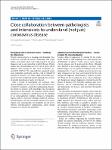Item Infomation
Full metadata record
| DC Field | Value | Language |
|---|---|---|
| dc.contributor.author | Christoph, Brochhausen | - |
| dc.contributor.author | Thomas, Bein | - |
| dc.contributor.author | Vittorio, Fineschi | - |
| dc.date.accessioned | 2023-03-27T04:38:43Z | - |
| dc.date.available | 2023-03-27T04:38:43Z | - |
| dc.date.issued | 2023 | - |
| dc.identifier.uri | https://link.springer.com/article/10.1007/s00134-022-06917-5 | - |
| dc.identifier.uri | https://dlib.phenikaa-uni.edu.vn/handle/PNK/7167 | - |
| dc.description | CC BY | vi |
| dc.description.abstract | Despite improvements in imaging and diagnostic procedures in critically ill patients presenting with organ failure, uncertainty often exists with regard to the exact diagnosis and a corresponding targeted therapy. Recent studies have demonstrated an error rate of up to 44% in diagnosis after autopsy [1]. The novel coronavirus disease 2019 (COVID-19)—especially the associated severe acute respiratory syndrome—led to a rush of critically ill patients to intensive care units, which were neither prepared in terms of staff and logistic demands nor in terms of specific knowledge of such a new disease. | vi |
| dc.language.iso | en | vi |
| dc.publisher | Springer | vi |
| dc.subject | Despite improvements | vi |
| dc.subject | diagnostic procedures | vi |
| dc.title | Close collaboration between pathologists and intensivists to understand (not just) coronavirus disease | vi |
| dc.type | Book | vi |
| Appears in Collections | ||
| OER- Y học- Điều dưỡng | ||
Files in This Item:

